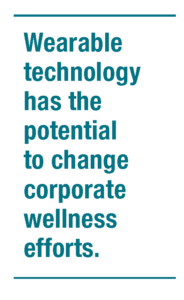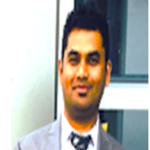Introduction
Health monitors, smartwatches, and fitness trackers are widely used in corporate and hospital wellness initiatives. These tools provide individualized guidance, track development, and keep an eye on health. Better integration of wearable technology is needed. The “Fused Environment Method” blends the physical and digital realms to integrate wearable technology better. This technique produces a fluid real-world virtual user experience that increases engagement and encourages good wellness program behaviors. The Fused Environment Method could improve health outcomes, good behaviors, and health outcomes. It aids businesses in implementing data-driven wellness programs for the workplace and healthcare, which may save healthcare costs by enhancing preventive care and minimizing expensive treatments. 1,2
Purpose
The purpose is to provide a thorough knowledge of how wearable technology may substantially influence employee well-being efforts and deliver tailored, data-driven solutions to improve employee health and productivity.3
- Highlight the Benefits:The goal is to highlight the advantages of using wearable technology in corporate wellness initiatives. This promotion entails discussing how wearable technology may provide real-time feedback, monitor health data, and encourage workers to develop better routines. By highlighting these benefits, organizations may appreciate the importance of incorporating wearable technology into their health efforts.
- Share Execution Techniques: The objective of sharing is to provide practical advice on successfully integrating wearable technology into corporate wellness initiatives. These suggestions involve going through the essential procedures and factors to choose suitable wearables, incorporating them into current wellness initiatives, and assuring employee motivation and participation. Organizations may use wearable technology to improve their health by exchanging best practices.
- Imagine the Future:This future focus goal is to investigate the possible effects of wearable technology on the workplace in the future. New options emerge as people talk about advanced trends, wearable technology breakthroughs, and potential policy and research ramifications. Organizations may proactively alter their health initiatives to take advantage of new possibilities by imagining the future of wearable technology.4
- Create a Wellness Culture:Ultimately, the goal is to highlight the importance of creating a wellness culture at work that is ingrained. By integrating wearable technology, organizations foster a culture that supports worker well-being, promotes healthy habits, and raises overall productivity.
Methods
The Fused Environment Method is an innovative technique that fuses the real and virtual worlds to provide an unsurpassed experience for the user. It has many uses in improving corporate wellness programs, including the Fused Deposition Modelling (FDM) printing process, which is becoming more prevalent. The extraordinary 3D printing process known as FDM printing enables the construction of wearable technological equipment that can intricately create products to meet the specific requirements of individual workers. The following investigation focuses on ways FDM printing might change and improve corporate wellness efforts.
FDM printing makes it possible to manufacture wearable technological gadgets personalized to meet each worker’s unique needs. With meticulous detail, these devices are created to address the custom  requirements of individual workers. Smartwatches may be tailored with features that cater to the personal tastes and goals of the user. At the same time, fitness trackers can be meticulously constructed to give the highest comfort and accuracy across various wrist sizes. Organizations can provide wearable gadgets that are highly functional and optimized for the individual’s comfort and convenience if they use the possibilities offered by FDM printing.
requirements of individual workers. Smartwatches may be tailored with features that cater to the personal tastes and goals of the user. At the same time, fitness trackers can be meticulously constructed to give the highest comfort and accuracy across various wrist sizes. Organizations can provide wearable gadgets that are highly functional and optimized for the individual’s comfort and convenience if they use the possibilities offered by FDM printing.
The capability of FDM printing to produce quick prototypes is one of the most important benefits of this printing method. Traditional approaches often require lengthy design, development, and testing cycles when creating wearable technological gadgets. This procedure, however, may be completed much more quickly thanks to FDM printing, which enables rapid prototyping. Because FDM printers allow for rapid iteration of various designs, features, and functions, businesses may dramatically save time and money often spent on traditional prototype techniques. Because of this efficiency, companies can rapidly improve their wellness gadgets to ensure that they continue to satisfy the ever-evolving requirements of their workforce.
FDM printing has emerged as a viable option for fabricating wearable technological gadgets in an age increasingly characterized by environmental consciousness. Using eco-friendly materials, such as recycled industrial resources, allows businesses to significantly lessen their negative influence on the surrounding environment while fostering a workplace sustainability culture. Because of its flexibility, FDM printing makes it possible to create wearable gadgets that are useful and visually pleasing, encouraging responsible consumption and contributing to the reduction of waste. Using environmentally friendly materials helps cultivate a culture of environmental stewardship and social responsibility inside a company, aligning corporate wellness initiatives with larger ecological aims.
FDM printing makes integrating wearable technology devices and virtual worlds easier, opening a new field of exciting possibilities. Using this cutting-edge method, companies can manufacture augmented reality (AR) and virtual reality (VR) headsets that seamlessly adjust to various head sizes and shapes. The flexibility to customize these gadgets enables the highest possible level of comfort and immersion, which enriches the virtual experience for workers participating in wellness programs. By using FDM printing, businesses can release the full potential of virtual environments, which in turn helps to encourage engagement, motivation, and general well-being.
FDM printing makes it possible to create wearable technological gadgets that may actively gather vital data on the health and well-being of employees. These gadgets, designed with sophisticated sensors, keep track of numerous elements of an individual’s health, including their patterns of physical activity and heart rate, as well as their sleeping habits and levels of stress. Organizations can build these data-driven devices by employing FDM printing, which enables gathering vast health indicators that can be evaluated using advanced machine learning algorithms. Wearable technologies can do this analysis and subsequently provide individualized suggestions. These recommendations may provide workers with practical insights and help them along their path to improved well-being.
Outcomes in Burnout and Health Issues
Wearable technology has the potential to change corporate wellness efforts. It can provide tailored advice, real-time criticism, and virtual coaching to enhance employee health and happiness. Organizations may adopt a data-driven and personalized approach to employee welfare by employing machine learning algorithms and the Fused Environment Method. Wearable technology has the potential to increase physical well-being, offer virtual training programs, provide task-based checklists, assess recovery periods, and gather health data. These devices may also measure motion and motivate employees to live healthier lifestyles. Adopting such technology enables employees to take control of their health, enhancing wellness and increasing productivity. Companies need to stay on top of the most current trends and advancements in wearable technology to retain the effectiveness and engagement of their corporate wellness programs. 5
Health Education and Lifestyle
Wearable technologies help employees modify their lifestyles and learn about health. Wearables may promote health education in numerous ways:
- Monitoring Health Metrics:Wearable devices may track employee heart rate, sleep habits, and physical activity. Wearable gadgets may teach workers about healthy living and highlight areas for development by providing real-time feedback on these measures.
- Virtual Coaching:Wearable gadgets may give health-based virtual coaching to workers. This coaching may include tailored fitness, diet, and stress management advice. Wearable technologies teach workers good behaviors by tailoring customized recommendations.
- Gamification:Wearable gadgets may make wellness exercises more fun for workers. Virtual challenges, leaderboards, incentives, and badges are possible. Wearable devices teach workers about healthy living via gamification.
- Incentivizing Healthy Behaviors:Wearable technologies may encourage healthy habits like taking breaks, keeping hydrated, and getting enough sleep. Wearable gadgets teach workers about healthy habits by offering incentives.
- Health Education Resources:Employees may access articles, movies, and podcasts on their wearable devices. Wearable gadgets encourage healthier lifestyles by providing staff with instructional resources.
Health Plans and Cost Reduction
Wearable technology adoption by health plans may result in a considerable drop in overall healthcare expenditures. Wearable technology may help to avoid pricey health issues and lessen the need for costly medical treatments by emphasizing preventative care, obtaining real-time data, and boosting patient engagement. The ability to influence behavior, self-report health metrics, provide individualized suggestions, and gather data in real-time throughout the day are all capabilities of wearable technology. Thanks to wearable technology, employers can now take a data-driven, tailored approach to employee wellness, lowering total healthcare expenditures and improving health outcomes. Businesses must keep up with all recent innovations and breakthroughs in wearable technology to fully use the potential offered by these devices within their health programs.
Conclusion
Finally, wearable technology in corporate wellness programs may enhance employees’ health and promote a wellness culture. Wearable gadgets deliver real-time feedback, health data, and personalized counsel to employers. Wearable technology strengthens the Fused Environment Method by seamlessly merging the physical and virtual worlds, creating a more immersive and engaging health experience. Using AR, VR, and other cutting-edge platforms, companies may use the Fused Environment Method to provide virtual coaching, gamify health activities, and build community among their employees. Encouragement to participate, be engaged, and accept responsibility boosts employee engagement and program effectiveness. The Fused Environment Method’s machine learning algorithms enable organizations to analyze wearable technology’s massive data sets, where subsequent analysis of patterns and trends provides employees with tailored suggestions and insights.
Wearable technologies and the Fused Environment Method boost corporate wellness beyond physical health. These technologies enhance stress management, mental health support, and work-life balance. Virtual worlds effortlessly integrate into the office, allowing employees to access information, engage in virtual fitness programs, and get real-time feedback that addresses employee well-being holistically. Wearable technologies and the Fused Environment Method may transform employer health initiatives by providing companies with data-driven, customized solutions promoting better lifestyles and employee well-being. The outcome boosts employee satisfaction, long-term performance, and productivity by creating a healthy, thriving environment.
Endnotes
1 E. M. Benssassi, J. -C. Gomez, L. E. Boyd, G. R. Hayes and J. Ye, “Wearable Assistive Technologies for Autism: Opportunities and Challenges,” in IEEE Pervasive Computing, vol. 17, no. 2, pp. 11-21, Apr.-Jun. 2018, doi: 10.1109/MPRV.2018.022511239, https://bit.ly/3OZcgAy.
2 M. A. A. Mamun and M. R. Yuce, “Sensors and Systems for Wearable Environmental Monitoring Toward IoT-Enabled Applications: A Review,” in IEEE Sensors Journal, vol. 19, no. 18, pp. 7771-7788, 15 Sept.15, 2019, doi 10.1109/JSEN.2019.2919352, https://bit.ly/45vVOx7.
3 T. Kiryu, T. Moriya, and Y. Mizuno, “Design of wearable units for personal fitting process in a wellness environment,” IEEE EMBS Asian-Pacific Conference on Biomedical Engineering, 2003., Kyoto, Japan, 2003, pp. 42-43, doi: 10.1109/APBME.2003.1302574, https://bit.ly/45aZ69m.
4 V. Misra et al., “Flexible Technologies for Self-Powered Wearable Health and Environmental Sensing,” in Proceedings of the IEEE, vol. 103, no. 4, pp. 665-681, April 2015, doi: 10.1109/JPROC.2015.2412493, https://bit.ly/3OYIlsc.
5 S. Kim, J. We and B. Cho, “A wearable thermoelectric generator fabricated on a glass fabric,” Energy Environ. Sci., vol. 7, no. 6, pp. 1959-1965, 2014, https://bit.ly/47CyfEW.

